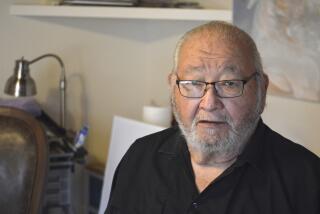Lewis Mumford, 94; Author, Critic and Commentator on Urban Growth
- Share via
Lewis Mumford, a philosopher, historian and architecture critic who had an enormous impact on American thought for much of this century, has died of natural causes at his home in southeastern New York. He was 94.
Mumford’s daughter, Alison Mumford Morss, said his death Friday afternoon was not unexpected. Her father had become “extremely frail” in recent years, she said, adding, “I think basically he died of old age.
“I feel very happy for him,” Morss said. “About 20 years ago, he realized he had done everything he set out to do,” and that gave him considerable satisfaction.
During his most prolific period as an author, roughly from 1920 to 1970, Mumford’s brilliant but unpretentious writings set the terms of historical debate over urban growth and the impact of technology.
In his books, and in a column for The New Yorker magazine, Mumford pestered planners and builders with fundamental questions:
“Why don’t skyscrapers have windows you can open to get fresh air?” Mumford asked, as tall buildings began to alter the scale of cities.
“Why must city neighborhoods be destroyed to appease the automobile?” Mumford wondered as urban planners brought highways right into cities after World War II.
Mumford never finished college, but his curiosity was so vast and his intellect so wide-ranging that he not only was the country’s most famous urban historian, he also helped American readers rediscover one of their greatest novelists, Herman Melville.
The 19th-Century author had fallen into obscurity when Mumford’s short psychological study of him in the 1920s set off a renewed interest that has never abated.
Mumford wrote more than two dozen books, including “The City in History,” a philosophical study of the role of cities throughout recorded history. Scholarly yet easy to read, this book has been acclaimed by numerous critics as the greatest ever written about the city as a physical and psychological place. It won a National Book Award in 1962 and was widely used in university classrooms.
In a way, Lewis Mumford was born too late. By the year of his birth, 1895, riveted steel frames and electric elevators were suddenly making it possible to construct very tall buildings. The age of the skyscraper was at hand, and it was the fate of Mumford--a man whose ideal was the New England village--to be a major observer of this age.
When Mumford was born, the tallest building in New York City was only 23 stories high. When he died, a building that high would not even make the list of the 200 tallest structures in the city.
By the time of his death, many critics agreed with Mumford’s 1955 prediction that Manhattan “would be so crowded (with buildings) that architecture will cease to matter.”
In his later years, Mumford preferred to live and write in Amenia, a small town near the Connecticut state line, 100 miles from Manhattan. But his biographer, Donald L. Miller, noted that Mumford was “an urban man to the core, a product of Walt Whitman’s ‘mettlesome, mad, extravagant’ New York.”
Miller wrote that Mumford was an extremely self-confident thinker and writer, but that it was all self-made. Mumford was illegitimate, and not until he was 47 years old did his mother tell him who his father was, a man with whom she had had a brief affair while working as his housekeeper.
Mumford grew up on the Upper West Side of Manhattan and early on developed the technique that was to distinguish his writings from those of many other urban historians and architecture critics. It was simple, he later said: You have to get out into the city, into the neighborhoods, and look at how buildings and streets affect everyday life.
His mentor was Patrick Geddes, a Scottish biologist and philosopher who helped plan cities in England that incorporated open space for recreation and the raising of food. Mumford was very interested in these “garden cities” and hoped the idea would catch on in America. He once wrote that Geddes had taught him how to study a city, “not as a collector of statistics or a maker of abstract models, but . . . as a citizen and a worker, participating in the total life of a community.”
Mumford was fascinated with the quality of life in the “age of the machine.” In “Sticks and Stones” (1924), one of the best books of its day about American architecture, Mumford wrote:
“Whereas in the first stage of industrial development the factory affected the environment of architecture, in its latest stage the factory has become the environment. A modern building is an establishment devoted to the manufacture of light, the circulation of air, the maintenance of uniform temperature and the vertical transportation of its occupants.”
Mumford, who studied at City College of New York but never got a degree, was a visiting professor at a number of colleges in the United States, England and Switzerland. For many years he wrote “The Sky Line,” a column about architecture, for The New Yorker.
He constantly sought answers to such questions as “What is transportation for?” He believed that keeping these basic questions before society would force politicians, planners and builders to address human needs in the relentless march of progress.
Architecture critic Paul Goldberger once wrote of Mumford: “He did not review buildings solely as aesthetic objects, nor solely as sociological phenomena, nor only as economic or political entities. To Mr. Mumford, a building was all those things, and it was the critic’s obligation to touch all those bases. And so he evaluated the United Nations complex as a symbol of its institution’s values, as a functional environment for its workers and as an aesthetic object.”
Born the year the automobile was patented in America, Mumford was unprepared for man’s fascination with the motorcar as an instrument of pleasure. But he rightly predicted one of the results of its invention.
People use automobiles to escape urban density and to get to the open countryside, he said, “but the highways necessary for that escape will eventually wipe out the very areas of freedom they sought.”
Mumford would have preferred that people live in cities interspersed with open spaces, and that these cities be separated by large green belts that barred sprawling housing tracts. As for the office buildings where modern man spends so much of his time, Mumford would have settled for windows that opened. He decried the steel and glass that paid no respect to “the meteorological, biological or psychological knowledge.”
His favorite American architecture was the original campus of the University of Virginia, designed by Thomas Jefferson. Reading Mumford, it is not hard to imagine the author and Jefferson striding together across the campus’ broad, tree-shaded lawn, two Renaissance men absorbed in the exchange of ideas.
Mumford was not a modern man. And if there was ever any doubt about that, he gave himself away in “The City in History” when he reminded the reader--in an unmistakably wistful tone--that the loudest sound in a 16th-Century town was the tolling of the church bell.
“He was a great believer in a balance in life,” Morss said. “Since the 1920s on, he ran a totally organic garden. He did do a lot of things that people are discovering now. He did that 50 years ago.
“He had that kind of mind that sees ahead better than it sees behind,” Morss said.
Mumford also is survived by his wife, Sophia, 90, who was with him at his death; and grandchildren Elizabeth Morss, an attorney in Albany, N.Y., and James Morss, an editor living in New York City.
There was no funeral for Mumford, who was cremated Saturday, Morss said. Plans are pending for a memorial service at a later date.
More to Read
Sign up for our Book Club newsletter
Get the latest news, events and more from the Los Angeles Times Book Club, and help us get L.A. reading and talking.
You may occasionally receive promotional content from the Los Angeles Times.









